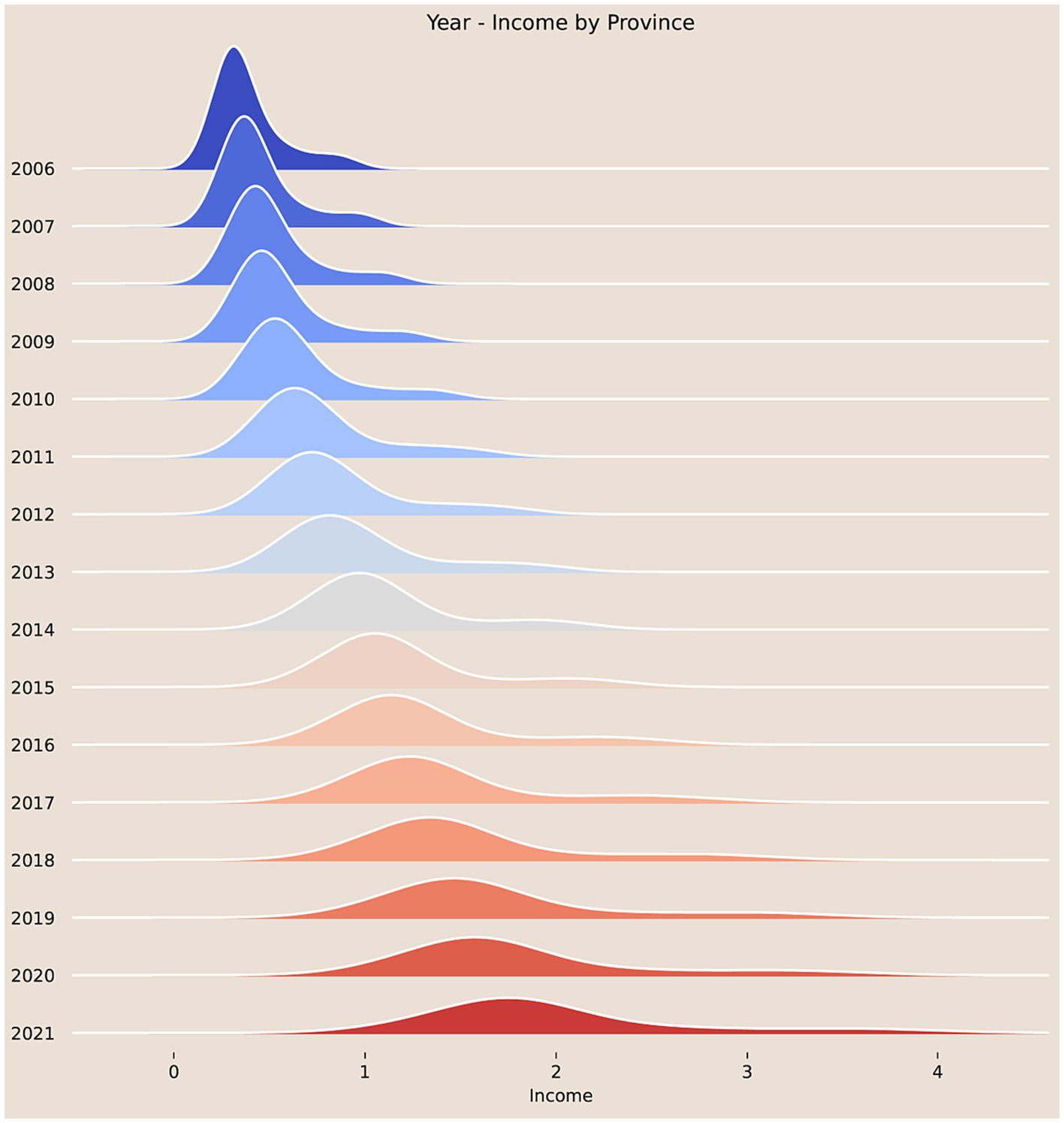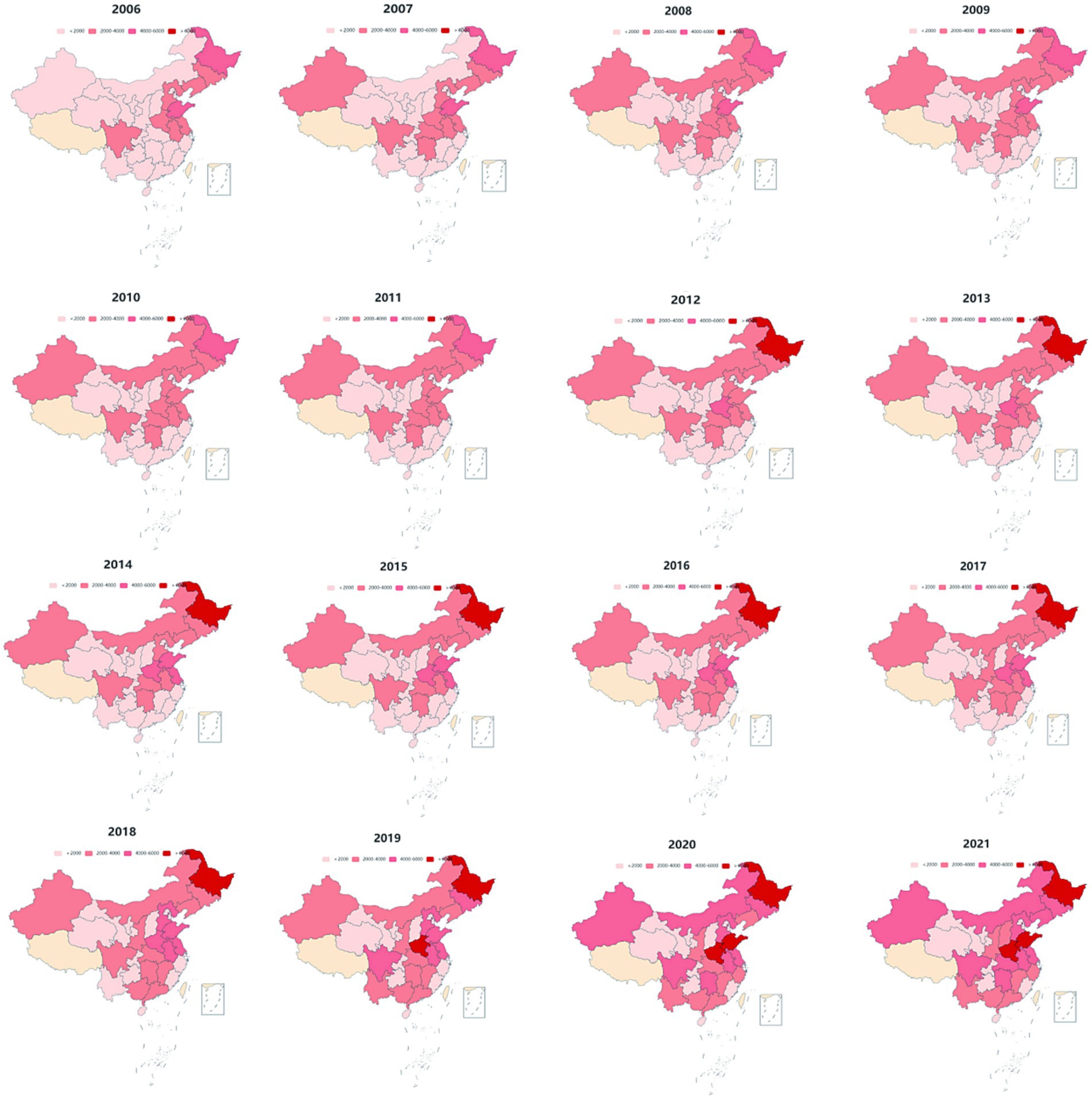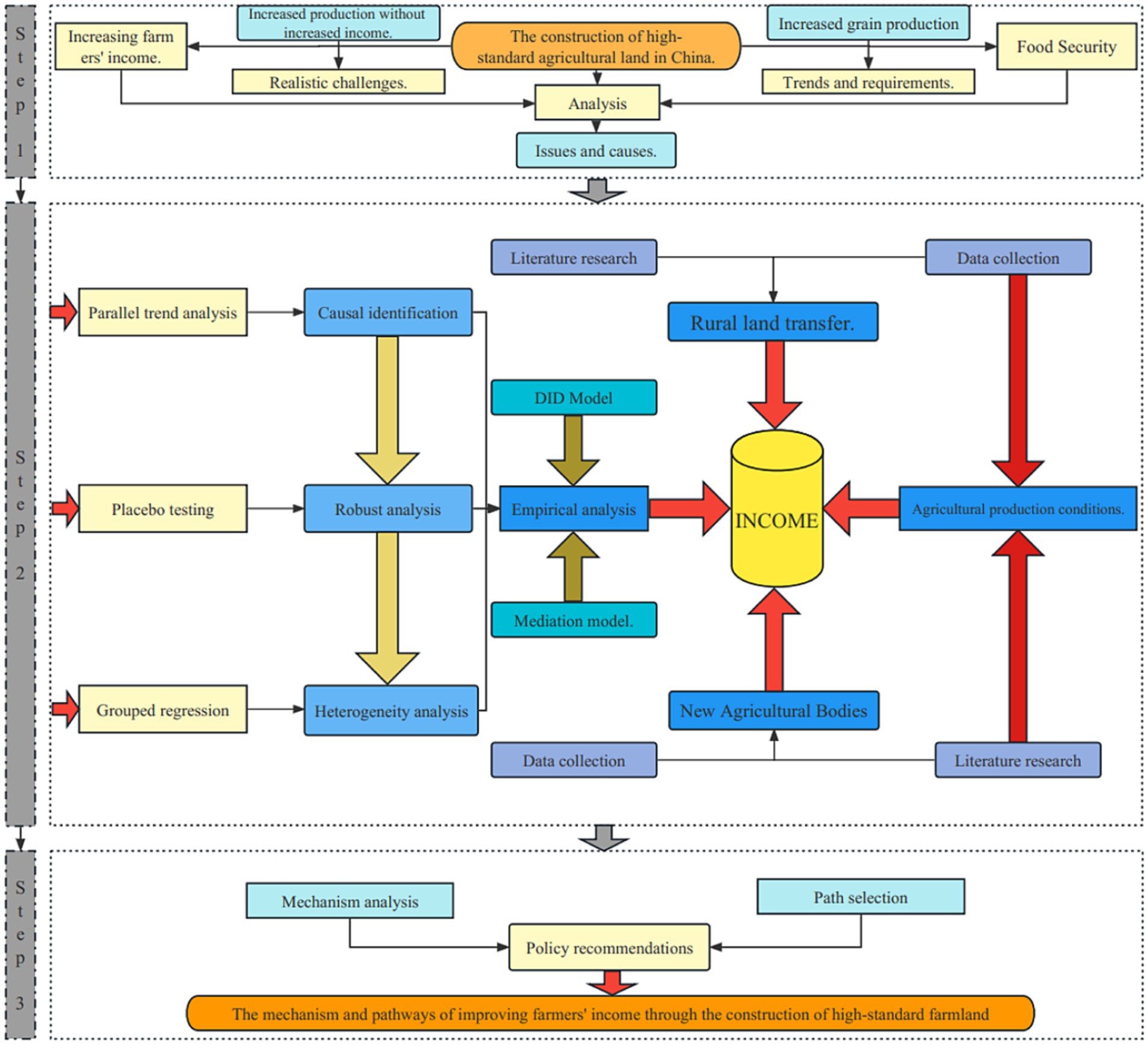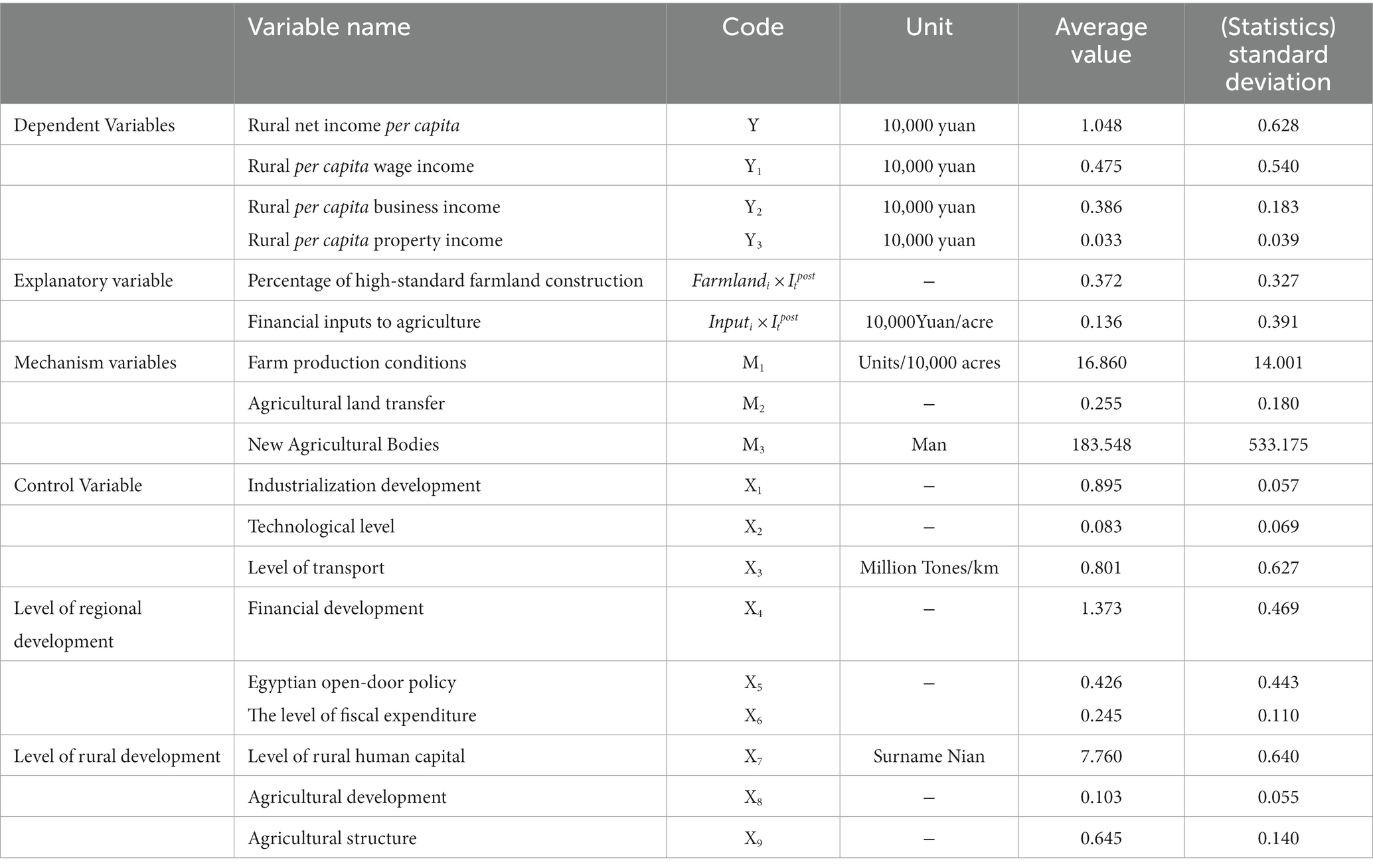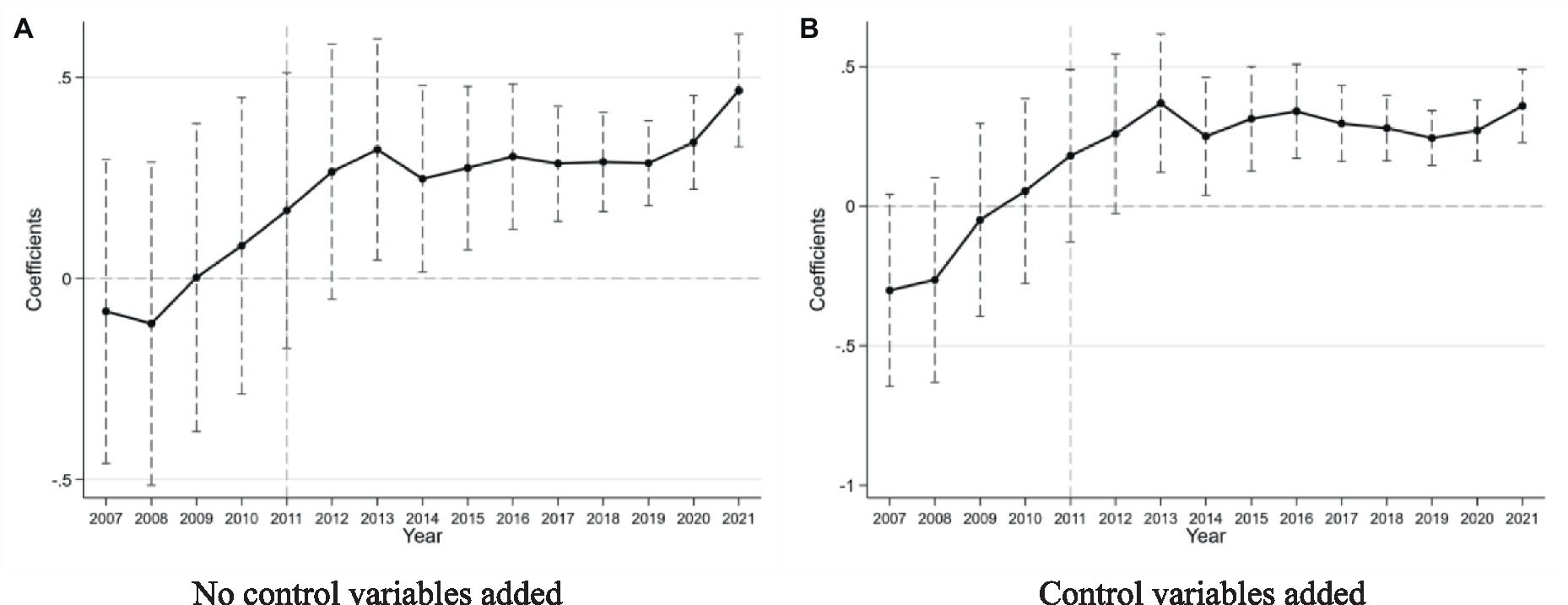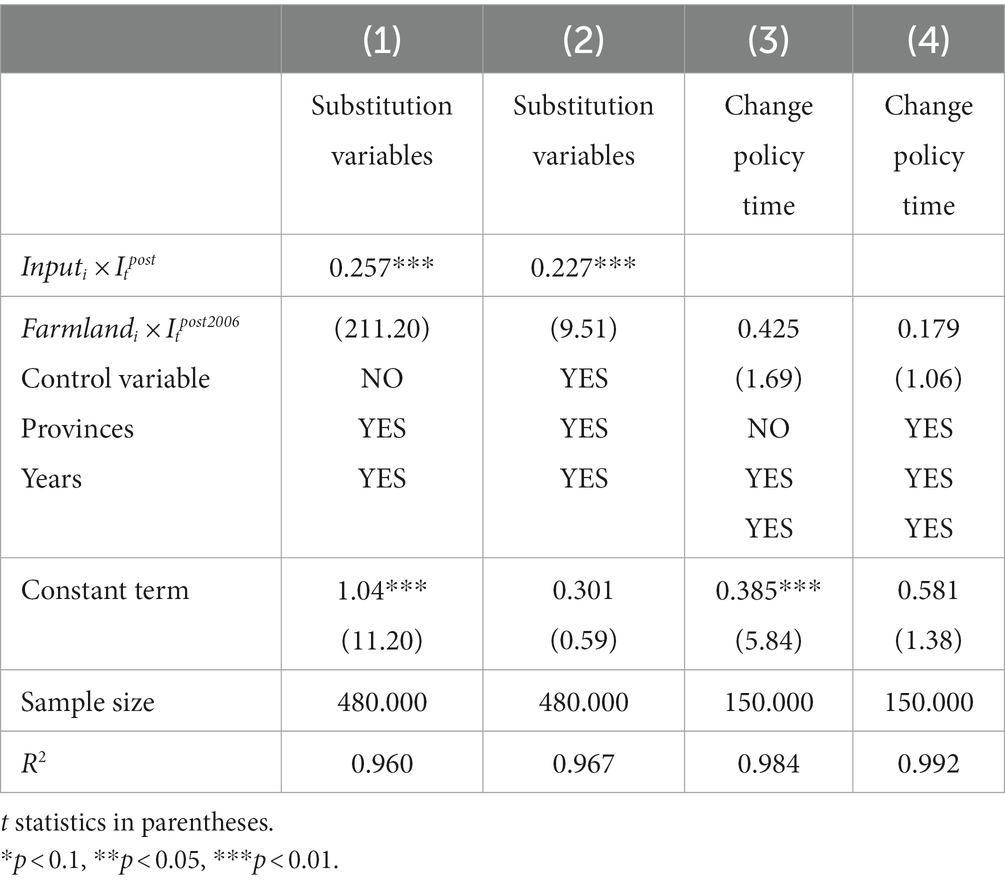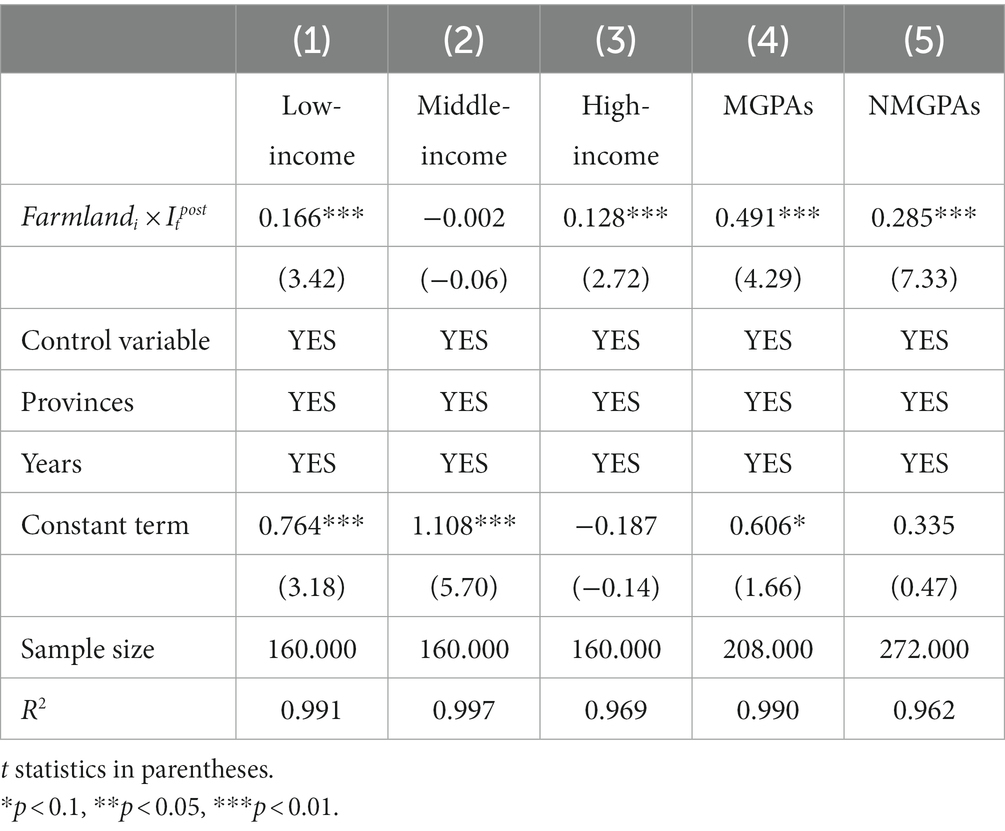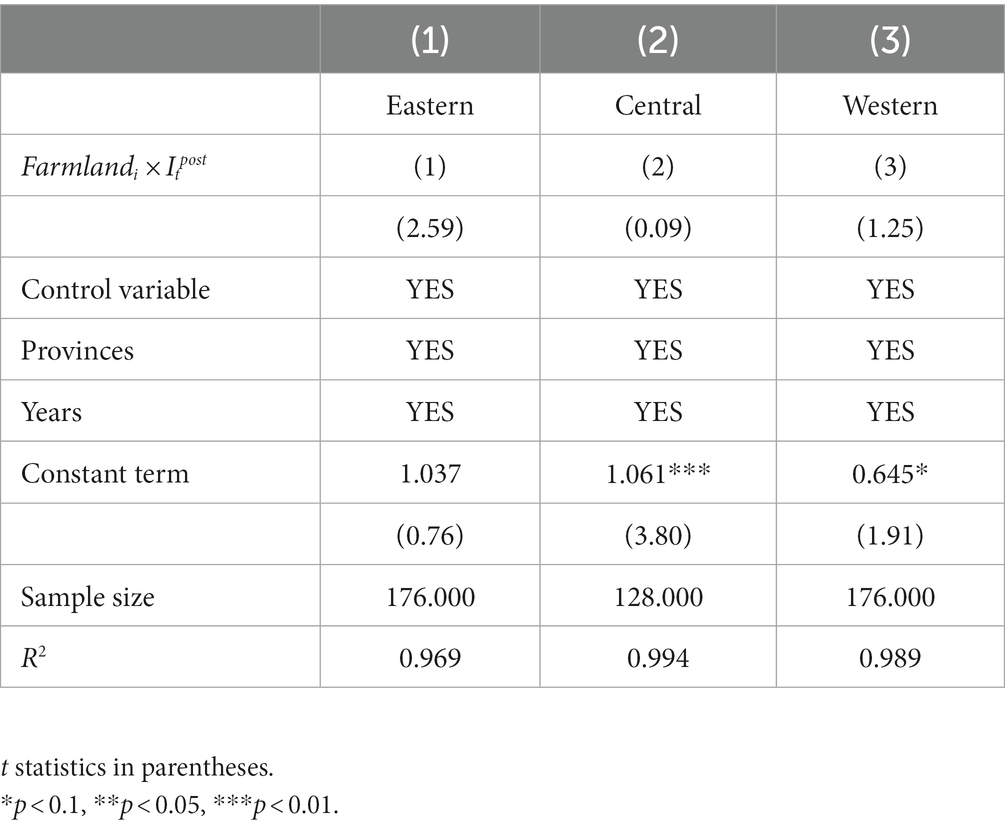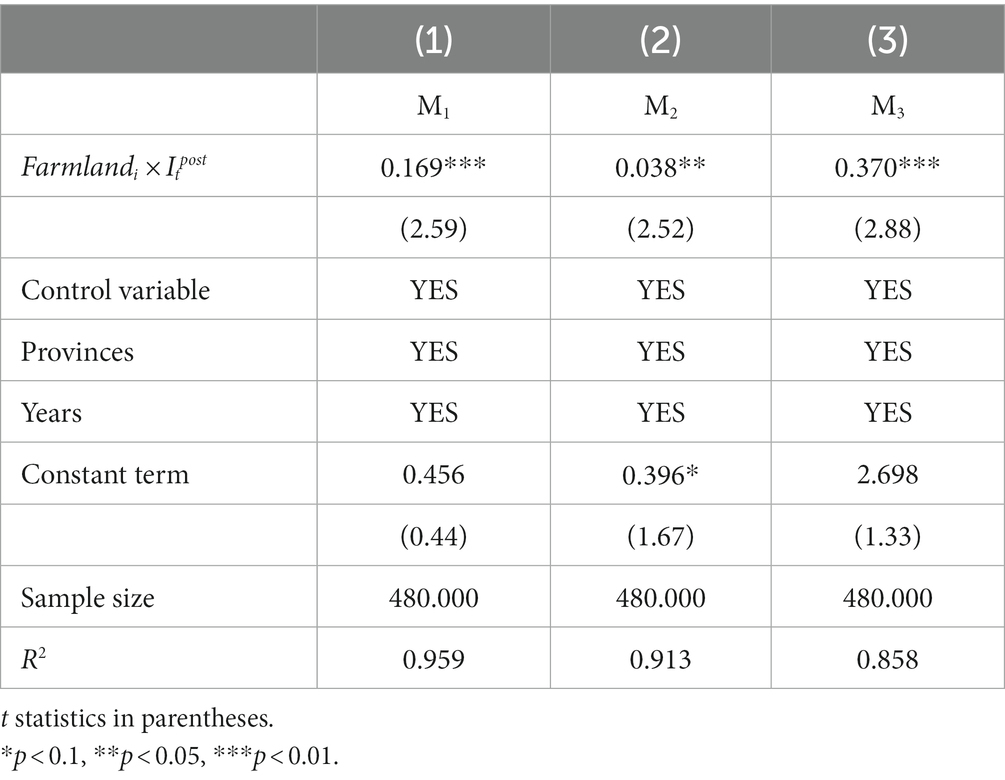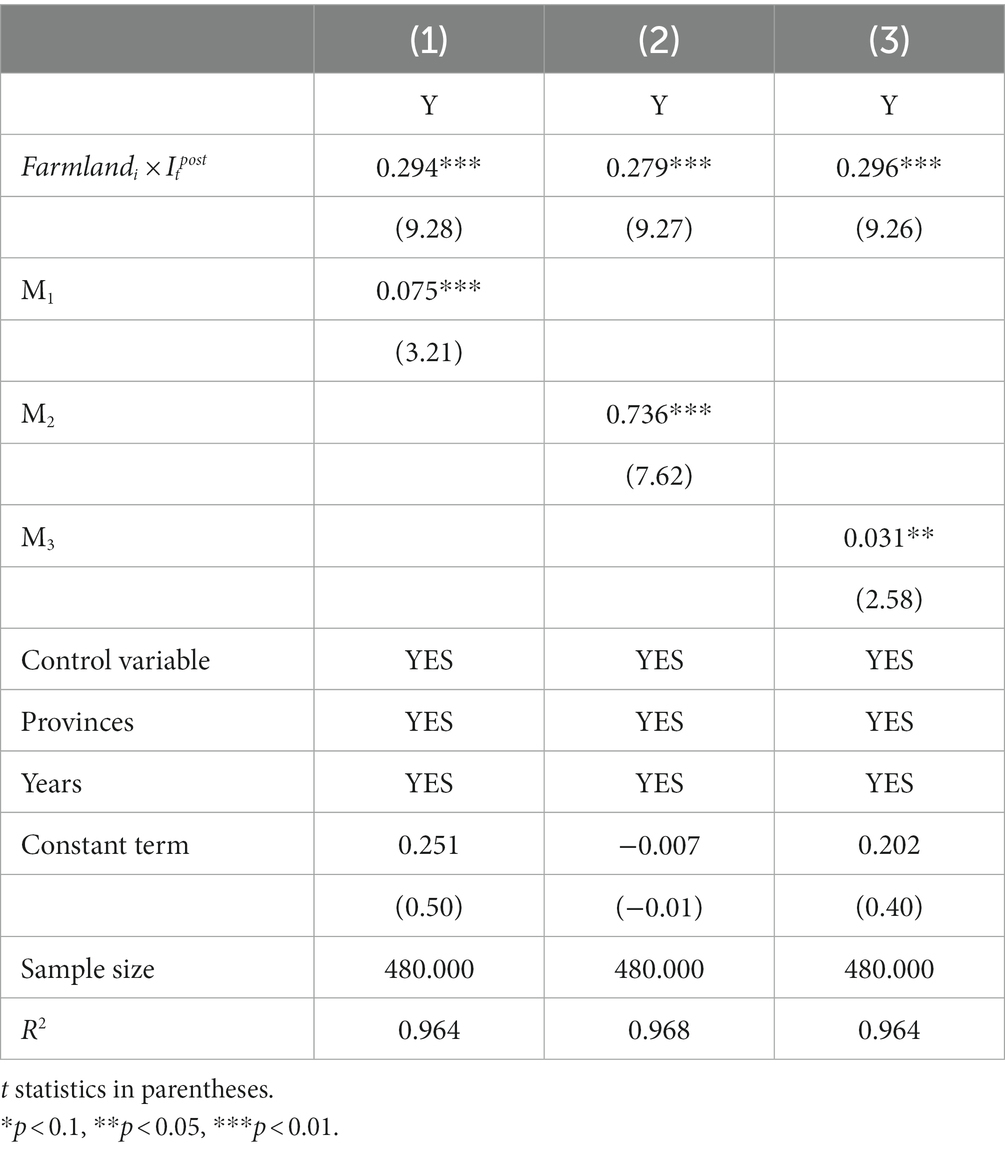- 1School of Management, Ocean University of China, Qingdao, China
- 2Department of Rural Economy, Development Research Centre of the State Council, Beijing, China
This paper examines the impact of high-standard basic farmland construction on farmers’ income in China using panel data at the provincial level from 2006 to 2021. The study aims to provide insights into the relationship between high-standard basic farmland construction and farmers’ income by employing a difference-in-differences model. The research background of this study is rooted in the importance of agricultural development and rural income improvement in China. As the agricultural sector plays a crucial role in ensuring food security and rural stability, it is essential to explore the effects of high-standard basic farmland construction on farmers’ income. The primary objective of this research is to estimate the impact of high-standard basic farmland construction on farmers’ income and to identify any heterogeneity in this relationship across different regions and income levels. By analyzing the baseline regression results, the study finds a significant positive effect of high-standard basic farmland construction on farmers’ income. To gain a deeper understanding of the mechanisms underlying this relationship, the study conducts further analysis on the impact pathways. The findings suggest that high-standard basic farmland construction enhances farmers’ income through improvements in agricultural production conditions, land transfer levels, and the cultivation of new agricultural management entities. Furthermore, the study explores the role of high-standard basic farmland construction in grain-producing and non-grain-producing regions. In grain-producing regions, high-standard basic farmland construction primarily increases farmers’ income from family-operated businesses. Conversely, in non-grain-producing regions, it predominantly boosts farmers’ income from wages and property. Overall, this research contributes to the understanding of the impact of high-standard basic farmland construction on farmers’ income in China. The findings highlight the importance of promoting high-standard basic farmland construction for rural income improvement, with implications for agricultural policies and rural development strategies.
1 Introduction
With the advancement of globalization, urbanization, and industrialization, global poverty and inequality have become global issues. The international community has attached great importance to poverty reduction, making “eradicating all forms of poverty” the primary goal of the United Nations’ 2030 Agenda for Sustainable Development. According to World Bank statistics, approximately 750 million people still live below the extreme poverty line globally, with the majority being farmers engaged in agricultural work. Therefore, ensuring stable income growth for farmers is crucial for reducing global poverty and achieving sustainable agricultural development. Agricultural growth and increased income for farmers have always been important topics for developing and developed countries, especially in developing countries where a significant portion of the labor force is engaged in agriculture. The income level of farmers directly affects their quality of life and social stability. China, as the world’s largest developing country, has made significant contributions to global poverty reduction by lifting 770 million rural poor out of poverty since 1978, based on the current poverty standards. In fact, the Chinese government has always attached great importance to increasing farmers’ income. The 20th National Congress of the Communist Party of China explicitly stated that “the most arduous and challenging task of promoting common prosperity still lies in rural areas” (Xi, 2022), demonstrating the government’s commitment to improving farmers’ income. At the same time, to ensure China’s food security, the government announced the comprehensive construction of high standard farmland nationwide since 2011, specifying that high standard farmland should only be used for food production. Generally, farmers who grow crops often face the problem of increasing production without a corresponding increase in income. However, in China, the widespread implementation of high standard farmland construction has not only increased food production but also seemingly stimulated the growth of farmers’ income, particularly in the main grain-producing areas of China, where farmers’ income has become more stable and rapid. Therefore, this study argues that it is essential to clearly address whether and how high standard farmland construction can mobilize the enthusiasm of construction tasks in major grain-producing areas and ensure a continuous increase in farmers’ income on the constructed high standard farmland.
Although the income level of rural residents in China has been steadily increasing in recent years, the ratio of per capita income between urban and rural areas has decreased from 2.88 in 2012 to 2.5 in 2021. However, there still exist issues of imbalanced and insufficient development. By observing Figure 1, it can be seen that each ridge in the figure represents the density curve of per capita net income of rural residents in each province for each year, while the peaks represent the high points or dense areas of variable values within that year. Although there has been a gradual rightward shift of the ridges from 2006 to 2021, indicating a steady increase in per capita net income of rural residents in China, the ridges have gradually transitioned from being steep to becoming more gentle over time. This suggests that while the per capita net income of rural residents in China has been continuously increasing, the income disparity between provinces has been widening, especially in terms of the internal income structure between major grain-producing regions and non-grain-producing regions. The major grain-producing provinces are often financially constrained, yet they bear the main responsibility for transforming low-yield and high-standard farmland. This implies that in the future, major grain-producing regions will undertake the task of constructing high-standard farmland, which not only affects the structural fiscal imbalance between grain-producing regions and non-grain-producing regions but also affects the structural income disparity among different regions and industries. Promoting income distribution system reform and further narrowing regional and income disparities are the paths towards achieving shared prosperity for all. Therefore, addressing the issue of effectively increasing the income of grain farmers in major grain-producing regions and narrowing the income gap between them and farmers in non-grain-producing regions has become an urgent matter to achieve common prosperity for the entire population.
Currently, numerous scholars have conducted in-depth discussions on the issue of increasing farmers’ income, providing a solid theoretical foundation for this study. American economist Schultz (1950) conducted profound reflections on rural poverty, emphasizing that reasonable agricultural policies are crucial measures for reducing rural poverty. In his theory of agricultural economic growth, he emphasized the need to transform traditional agriculture into modern agriculture. Similarly, Lewis (1954) emphasized that income levels in the traditional agricultural sector are generally low, leading to labor migration from the agricultural sector to cities, hindering sustainable agricultural development. Therefore, the key to increasing farmers’ income lies in how to transform traditional agriculture reasonably and improve agricultural productivity. Firstly, the increase in farmers’ income in a country or region is largely determined by the most basic agricultural production conditions, such as rural infrastructure construction and the level of agricultural mechanization (Barman and Deka, 2019; Kandpal et al., 2019; Wang et al., 2021; Sang et al., 2023). The main pathway is to improve agricultural labor productivity to increase household income from farming operations and promote non-agricultural employment to increase wage and property income for rural residents. Secondly, land is the most important production factor for farmers, and land systems, especially regulations related to agricultural land transfer, are crucial factors affecting farmers’ income (Zhou et al., 2019; Arsyad et al., 2020; Nandini and Rahayu, 2021; Deng et al., 2022). In more specific mechanisms, land transfer mainly promotes professional farmers to increase land operation scale and increase their income from agricultural operations, as well as facilitates part-time farmers’ transition to non-agricultural industries, improving their wage and property income (Yang et al., 2020; Geng et al., 2021). In addition, the integration of agricultural industries and new business models is a powerful guarantee for increasing farmers’ income. The upgrading of the agricultural industry structure based on the digital economy, the development of rural e-commerce, and leisure agriculture, among other new agricultural business models, collectively promote the sustainable growth of farmers’ income (Akhmadi and Yekti, 2021; Mishra and Vedasri, 2021; Singh et al., 2021; Guo et al., 2023; Zheng et al., 2023). Therefore, the key to achieving sustainable increases in farmers’ income lies in improving traditional agricultural production conditions, promoting orderly land transfer, cultivating new agricultural business entities, and promoting the coordinated development of multiple business models.
In fact, promoting agricultural land development and improving agricultural productivity is not unique to China. For example, Japan and South Korea focused on the development of agricultural infrastructure during the early stages of agricultural modernization, significantly improving the quality of farmland and overall agricultural productivity (Yi, 2012). In the United States, the emphasis during the process of agricultural modernization was on promoting mechanization in agricultural land matching, primarily driven by market forces to enhance mechanization levels. In the later stages of agricultural modernization in Germany, the focus shifted towards improving the quality of farmland, promoting ecological farming, and developing precision agriculture. There is still a gap between China’s high-standard farmland construction and the aforementioned developed countries. Taking the United States as an example, China differs from the United States in terms of agricultural modernization. China’s high-standard farmland construction is constrained by the scarcity of resources due to its large population and limited land availability. Although the total arable land area in China is approximately 300 million acres larger than that of the United States, the population of the United States is only 327 million, while China has nearly 1.4 billion people. This means that the per capita arable land in the United States is 5.3 times larger than that in China. The United States not only has an advantage in terms of arable land resources but also, during the process of agricultural modernization, experienced a significant outflow of agricultural population, leading to the gradual expansion of farm production and business scale. According to data from the United States Department of Agriculture (USDA) until 2012, the average farm size reached 26,319.9 acres, with family farms accounting for 87% of the total number of farms. By 2019, the agricultural population accounted for only 1.36% of the country’s total population. Therefore, China’s high-standard farmland construction differs from that of developed countries. On the one hand, China’s high-standard farmland requires comprehensive irrigation facilities to improve flood control and disaster reduction capabilities, as well as concentrated and contiguous construction to promote the mechanization of the entire agricultural production process, thereby improving the level of mechanized farming. On the other hand, high-standard farmland aims to increase labor efficiency, reduce agricultural production risks, and enhance the enthusiasm of professional farmers and the cultivation of new types of professional farmers (Chen and Hong, 2022; Zhao and Sun, 2022). Can China’s high-standard farmland construction, based on the national conditions, contribute to increasing farmers’ income? However, there is currently no research available on the relationship between high-standard farmland construction and farmers’ income. Current studies mainly focus on micro-level factors such as productivity, comprehensive supervision mechanisms, and facility construction (Xiong and Li, 2021; Dong et al., 2023; Mutelo et al., 2023). At the macro level, there are only studies using the Difference-in-Differences (DID) model to explore the causal relationship and pathways of the high-standard basic farmland construction policy in relation to fertilizer reduction, grain quality, and sustainable agricultural development (Gong et al., 2023; Li et al., 2023; Liu et al., 2023). However, the extent to which the high-standard farmland construction policy affects farmers’ income and the causal identification of this relationship still lack crucial evidence.
Building upon previous research, this paper expands the investigation in the following areas. Firstly, it will explore the underlying mechanisms through which the construction of high-standard farmland policy affects farmers’ income from multiple perspectives, including agricultural production conditions, rural land circulation, and the cultivation of new agricultural operating entities. Secondly, this study employs panel data from 30 provinces in China (excluding Hong Kong, Macao, Taiwan, and Tibet) from 2006 to 2021. Through the application of a continuous double difference (DID) model, it aims to eliminate the confounding impact of unobservable factors across time and space, and thus more accurately capture the differential effects resulting from variations in the implementation intensity of the high-standard farmland construction policy. This provides cleaner and more detailed causal evidence for the effect of the policy on farmers’ income. Lastly, this paper provides empirical testing of the impact mechanisms through which the high-standard farmland construction policy promotes farmers’ income growth, furnishing stronger empirical evidence for the underlying theoretical logic. Ultimately, this study aims to provide scientific evidence as a basis for future high-standard farmland construction initiatives aimed at increasing farmers’ income.
2 Policy background and theoretical analysis
2.1 Policy background of high-standard farmland construction
The construction of high-standard farmland is essentially a land governance policy that has evolved from the transformation and development of low-yield farmland. Since 1994, land governance projects have been specifically established within comprehensive agricultural development programs, with the main focus being the transformation of low-yield farmland. In 2004, the Central Document No.1 proposed the need to “focus on the construction of high-yield and stable- production basic farmland in the main grain-producing areas, especially in the central grain-producing areas, to ensure drought and flood resistance.” This was the first mention of the concept of high-standard farmland in the Central Document No. 1. Subsequently, the Party Central Committee and the State Council have put forward development models and construction goals for the high-standard farmland construction policy in various documents over the years, but no standardized policy documents have been formed. It was not until 2011, when the State Council promulgated the “National Land Consolidation Plan (2011–2015),” that specific requirements for the construction of high-standard farmland were explicitly stated. Since then, the “Central Document No.1,” the 14th Five-Year Plan, and the report of the 20th National Congress of the Party all repeatedly emphasized the need to “implement the construction of high-standard farmland” as an important measure to adhere to the red line of protecting 1.8 billion mu of arable land and safeguard food security.
According to the “Standard for Construction of High-Standard Basic Farmland (TD/T1033-2012)” issued in 2012, high-standard farmland, compared to ordinary farmland, is basic farmland that is formed through land governance, characterized by land leveling, contiguous and concentrated patches, supporting facilities, high and stable yields, good ecological conditions, strong disaster resilience, and compatibility with modern agricultural production and management practices. The most recent “General Principles for the Construction of High-Standard Farmland” (GB/T30600-2022) issued in 2022 has added basic principles such as “green ecology” and “suitability to local conditions.” It also sets the goal of cumulatively constructing 1.075 billion mu and improving 105 million mu by 2025, and achieving a cumulative construction of 1.2 billion mu and improvement of 280 million mu of high-standard basic farmland that can ensure drought and flood resistance, high and stable yields by 2030.
In Figure 2, we present the trends in the area of high-standard farmland construction in different provinces from 2006 to 2021. By analyzing Figure 2, we can draw the following conclusions. Since the Chinese government announced the comprehensive promotion of high-standard farmland construction in 2011, building upon the existing low-yield farmland, there has been a gradual increase in the area of high-standard farmland in China. Particularly, since 2018, the pace of high-standard farmland construction has been steadily accelerating. By 2021, the majority of provinces nationwide had surpassed an area of 20 million mu (approximately 1.33 million hectares) of high-standard farmland, with major grain-producing provinces exceeding 40 million mu (approximately 2.67 million hectares). These achievements highlight the significant success of China’s high-standard farmland construction policy.
2.2 Theoretical analysis of high standard farmland construction and farmers’ income increase
1. The construction of high-standard farmland is closely related to the improvement of agricultural production conditions and the increase in farmers’ income. Enhancing agricultural production conditions is the essential requirement of high-standard farmland construction. In practical terms, the transformation from fragmented land management to integrated and contiguous fields, land leveling, and concentrated farmland has been achieved through the combination of small plots into larger ones. This approach has expanded the scale of land operations. Furthermore, the construction of field roads has met the transportation needs of agricultural mechanization, thereby improving the level of mechanized farming. The establishment of sound agricultural water conservancy facilities, as required in high-standard farmland construction, enhances the resilience of farmland against disasters. The progress in agricultural production conditions, exemplified by the level of mechanized farming, holds the potential for increasing farmers’ income. Firstly, the improvement in agricultural mechanization promotes grain production and the transfer of surplus labor in agriculture, thereby increasing farmers’ income (Zhou et al., 2016). Secondly, the application of agricultural water conservancy machinery and infrastructure helps enhance farmers’ disaster resilience, which plays a significant role in increasing their income (Ge, 2004).
2. The construction of high-standard farmland, land transfer, the cultivation of new agricultural business entities, and the increase in farmers’ income are interconnected. High-standard farmland construction promotes progress in agricultural production and improves production efficiency. On one hand, it increases the willingness of new agricultural business entities to engage in land operations, thus promoting land transfer. On the other hand, it reduces agricultural production costs, allowing limited labor to operate more land and increasing the land management scale for new agricultural business entities. The logic behind land transfer and the cultivation of new agricultural business entities in increasing farmers’ income is as follows: Firstly, land transfer can expand the scale of land operations, improve agricultural production efficiency for incoming households, increase farmers’ operating income, and promote the transfer of agricultural labor to non-agricultural industries, thereby increasing farmers’ wage income. It can also increase farmers’ property income through land rental fees (Qian and Wang, 2016). Secondly, new agricultural business entities, such as family farms and large-scale grain producers, increase their operating income by enlarging the scale of land operations and improving the intensive utilization of cultivated land (Wu and Ma, 2021). Furthermore, agricultural cooperatives and agricultural enterprises can provide production and business services to farmers, expand channels for agricultural product sales, and increase farmers’ sales income (Lai et al., 2021). They can also explore diversified business models, guide farmers towards vertical integration in the “farmers-cooperatives-agricultural enterprises” chain, reduce production risks for farmers, and increase their income.
3. The intrinsic correlation between agricultural production conditions, land transfer, and the cultivation of new agricultural business entities exists due to the interplay of various mechanisms. Firstly, high-standard farmland construction includes the establishment of irrigation channels and farm machinery roads. On the one hand, the construction of farm machinery roads facilitates the operation of agricultural irrigation and drainage machinery. On the other hand, the increased drainage capacity of farmland also protects the farm machinery roads from damage caused by waterlogging. At the same time, high-standard farmland construction promotes the consolidation of fragmented land through methods such as the combination of small plots into larger ones. This improves the scale of land operations and effectively addresses the contradiction between the scattered intentions of farmers to transfer land and the demand of new agricultural business entities for consolidated land, thus fostering the cultivation of new agricultural business entities (Zhang and Qu, 2014). The cultivation of family farms and large-scale grain producers can directly stimulate more farmers to rent out their land, while the mutual assistance services of agricultural cooperatives can indirectly stimulate farmers to rent land. The combination of these factors promotes land transfer (Li and Qin, 2022). Therefore, land transfer and the cultivation of new agricultural business entities should mutually reinforce each other.
4. Differences in income generation pathways between farmers in main grain production areas and non-grain production areas. Since 2003, China has designated 13 provinces, including Shandong, Jiangxi, and Heilongjiang, as grain-producing regions. However, these “grain-producing provinces” often face financial challenges, and the issue of increased production without increased income has been a constraint on the sustainable development of agriculture. To achieve the goal of common prosperity, it is necessary to establish and improve compensation mechanisms for grain-producing regions to enhance the income of grain farmers (Wei and Wang, 2012). The high-standard farmland construction policy mainly targets grain-producing regions, with grain-producing regions accounting for approximately 70% of the total area of high-standard farmland. Can the construction of high-standard farmland reduce the structural income gap between grain-producing and non-grain-producing regions? In grain-producing regions, the land is fertile, and a high proportion of households engage in agricultural activities (Guo et al., 2023; Yang et al., 2023; Ye et al., 2023). The construction of high-standard farmland optimizes agricultural production conditions, improves the scale of farming operations, and reduces agricultural production costs (Peng et al., 2022; Li et al., 2023). Therefore, in grain-producing regions, the construction of high-standard farmland should primarily focus on improving agricultural production conditions to increase the operational income of farmers. In non-grain-producing regions, suitable land for cultivation is often limited. If the majority of households engage in agricultural production, it is often difficult to obtain substantial wages. Instead, specialized family farms and large-scale grain farmers are the main agricultural operators in these regions (Linghu et al., 2023). Most households transfer their land and shift to non-agricultural industries, promoting the cultivation of new agricultural management entities and obtaining wage and property income. Therefore, in non-grain-producing regions, the construction of high-standard farmland should aim to increase wage and property income for farmers.
Figure 3 represents the mechanism analysis diagram in this study. In Figure 3,This paper begins by raising the research significance of the sustainable income growth for farmers through the implementation of high-standard farmland construction. Subsequently, through theoretical analysis, the following hypotheses are proposed:
H1: The implementation of the high-standard farmland construction policy can increase farmers' income.
H2: High-standard farmland construction increases farmers' income through improving agricultural production conditions, land transfer, and the cultivation of new agricultural management entities.
H3: Land transfer and the cultivation of new agricultural management entities have a mutually reinforcing relationship, and agricultural production conditions promote land transfer and the cultivation of new agricultural management entities.
H4: In grain-producing areas, high-standard farmland construction primarily increases farmers' income from household operations, while in non-grain-producing areas, it mainly increases farmers' income from wages and property.
Subsequently, this paper will gradually verify these research hypotheses using the Difference-in-Differences (DID) model and the mediation effect model. Finally, conclusions will be drawn, and policy implications will be proposed based on the findings for further examination.
3 Model setup and data sources
3.1 Model set-up
3.1.1 Parallel trend test and analysis of policy dynamic effects
The fundamental assumption of the Difference-in-Differences (DID) model is the parallel trend test, which states that before 2011 (the time point when the policy takes effect), the income changes over time for both the treatment and control groups are consistent. If this assumption is not met, the DID model loses its meaning. Therefore, in this study, we construct the following model to test the parallel trends:
In the equation, Incomeit denotes the per capita net income of rural residents in the i-th province in period t; Farmlandi represents the proportion of high-standard farmland construction in the i-th province; Dt denotes the year dummy variable; Xit denotes the time-varying control variable; μi denotes the province fixed effect; γt denotes the year fixed effect; εit is the small disturbance term; α, β, and δ are the parameters to be estimated. If the implementation of high-standard farmland construction policy can significantly increase farmers’ income, then before the implementation of high-standard farmland construction policy, the interaction term of the area share of high-standard farmland construction and the year dummy variable on the coefficient of increase in farmers’ income, βt, should tend to be stable, i.e., the regression result should be insignificant. After the implementation of the policy, βt will rise significantly, i.e., the regression result should be significantly positive after the implementation of the policy.
3.1.2 Benchmark model
The high-standard farmland construction policy was not standardized before 2011. It was not until 2011 that the policy was uniformly implemented nationwide with a gradual and province-by-province approach. This implies that, on one hand, the area of high-standard farmland construction varies continuously across provinces at different implementation time points. On the other hand, at the same time point of policy implementation, the area of high-standard farmland construction differs among provinces. The differences in the implementation year and provinces of the high-standard farmland construction policy make it suitable as a “quasi-natural experiment” for policy research. In this study, we intend to utilize the Difference-in-Differences (DID) model to estimate the impact of the high-standard farmland construction policy on farmers’ income. It is worth noting that, due to the nationwide implementation of the high-standard farmland construction policy, it is not possible to artificially divide the treatment and control groups as in traditional DID models. Therefore, this study employs the continuous variable of “provincial proportion of high-standard farmland construction area” to distinguish the treatment and control groups, with provinces having a higher proportion naturally becoming the treatment group, while those with a lower proportion becoming the control group. Such a continuous DID model not only maintains the nature of the original DID model but also avoids biases caused by artificially setting up treatment and control groups, thus capturing more precise policy effects (Qian, 2008).
In order to identify the impact of high standard farmland construction policy on farmers’ income, this paper constructs model (2).
In the equation, Incomeit denotes the net per capita net income of rural residents in the ith province in period t; Farmlandi represents the proportion of high-standard farmland construction in the i-th province; Itpost denotes a dummy variable for the point of time when the policy is implemented; Xit denotes the time-varying control variable; μi denotes the province fixed effect; γt denotes the year fixed effect; εit is the small perturbation term; and α, βt and δ are the parameters to be estimated. Equation (2) controls the two-way fixed effects, and the estimated parameter βt is the net policy effect of implementing the high standard farmland construction policy on farmers’ income. Based on the previous theoretical analysis, this paper expects that the sign of βt should be positive.
3.1.3 Mechanism model.
To identify the pathway mechanism of the high-standard farmland construction policy on farmers’ income increase, this study constructs models (3) and (4).
Model (3) primarily examines the impact of high-standard farmland construction on agricultural production conditions, land transfer, and the cultivation of new agricultural management entities. In Equation (3), Mit represents the mechanism variable for the i-th province at time period t; Farmlandi represents the proportion of high-standard farmland construction in the i-th province.; Itpost represents a dummy variable for the policy implementation period; Xit represents time-varying control variables; μi represents province-specific fixed effects; γt represents year-specific fixed effects; εit represents the error term; α, β, and δ are the estimated parameters. Equation (3) controls for both province and year fixed effects, and the estimated parameter β represents the net policy effect of implementing the high-standard farmland construction policy on the mechanism variables in this study. Based on the theoretical analysis presented earlier, it is expected that the sign of β should be positive.
In Equation (4), Incomeit represents the per capita net income of rural residents in the i-th province at time period t; Farmlandi represents the proportion of high-standard farmland construction in the i-th province.; Itpost represents a dummy variable for the policy implementation period; Mit represents the mechanism variable for the i-th province at time period t; Xit represents time-varying control variables; μi represents province-specific fixed effects; γt represents year-specific fixed effects; εit represents the error term;α, β, η, and δ are the estimated parameters. Equation (4) controls for both province and year fixed effects, and the estimated parameter β represents the net policy effect of implementing the high-standard farmland construction policy on farmers’ income increase, while η represents the net effect of the mechanism variables on farmers’ income increase. Based on the theoretical analysis presented earlier, it is expected that the signs of β and η should be positive.
3.2 Data sources and selection of variables
1. Data source. Due to data availability limitations, this study utilizes panel data from 30 provinces (excluding Hong Kong, Macao, Taiwan, and Tibet) in China from 2006 to 2021. Some data have been transformed logarithmically and interpolated to complete missing values. Rural per capita net income, crop planting area, and other variables are obtained from the “China Rural Statistical Yearbook.” The data for high-standard farmland construction area from 2006 to 2017 are sourced from the “China Financial Yearbook,” while the data for 2018 to 2021 are obtained from the official website of the Ministry of Agriculture and Rural Affairs of the People’s Republic of China. Original data on agricultural mechanization levels are derived from the “China Statistical Yearbook,” while data on land transfer and the cultivation of new agricultural entities are obtained from the “China Rural Management and Administration Statistical Yearbook.” The remaining control variables’ original data are sourced from authoritative statistical yearbooks such as the “China Statistical Yearbook” and statistical yearbooks for respective provinces.
2. Dependent Variables. With reference to existing research practices, this paper takes rural per capita net income as an indicator for measuring the level of farmers’ income increase, and it is worth noting that after 2013, the National Bureau of Statistics changed the statistical caliber from rural per capita net income to rural per capita disposable income, which did not have a great impact on the relevant data despite the change in the statistical caliber. In further analyses of the mechanism, this paper further discusses rural per capita wage income, business income and property income. Finally, this study aims to adjust the agricultural workers’ income over the years by utilizing the Consumer Price Index (CPI) in order to mitigate the impact caused by inflation.
3. Explanatory variables. The core explanatory variable of this paper is the interaction term between the ratio of the area of high-standard farmland construction and the dummy variable of the time point of the implementation of high-standard farmland construction policy (Farmlandi × Itpost). The ratio of high-standard farmland construction area is the ratio of the area of high-standard farmland construction demonstration area and the area of renovated medium- and low-yield fields to the sown area of crops in each province, and the dummy variable of the pilot implementation of the high-standard farmland construction policy is set to 0 before 2011, and set to 1 in 2011 and after. In order to safeguard the robustness of the results of the study, this paper introduces the interaction term (Input) of the mu-per-capita investment in agriculture with the dummy variable of the high-standard farmland construction policy. To ensure the robustness of the research results, this paper introduces the interaction term of the variable (Input×Itpost), which is the ratio of the agricultural financial expenditure to the area of agricultural cultivated land in each province. The important content of agricultural capital investment is land governance, and the policy of high-standard farmland construction as a national agricultural policy, but the degree of agricultural capital investment in different provinces varies, resulting in the degree of construction of high-standard farmland in different places, which coincides with the purpose of this paper’s selection of the core explanatory variables (Farmlandi × Itpost).
4. Mechanism variables. According to the theoretical analysis in the previous section, this paper chooses the farmland production conditions, the level of farmland transfer and the level of cultivation of new agricultural management subjects as the mechanism variables in this paper, of which the farmland production conditions are measured by the level of farmland mechanized ploughing as the indicator. The level of farmland mechanized farming refers to the ratio of the number of large and medium-sized farming machinery to the area of agricultural cultivated land in each province; the level of farmland transfer refers to the ratio of the area of family contracted transfer to the area of family contracted operation in each province; and the level of cultivation of new agricultural business subjects refers to the ratio of the number of members of new agricultural business subjects to the number of new agricultural business subjects in each province, of which the new agricultural business subjects mainly refer to the agricultural professional co-operatives, which generally also include planting cooperatives, and the members of the professional co-operatives also include planting cooperatives. The members of professional co-operatives generally include large grain farmers, family farmers and members of agricultural enterprises.
5. Control variables. This paper divides the control variables into two categories. (1) The level of regional development: The industrialization development, the level of science and technology, the level of transport, the financial development, the level of opening up to the outside world, and the fiscal expenditure. The industrialization development refers to the ratio of the gross domestic product (GDP) of the secondary and tertiary industries to the GDP; The level of science and technology refers to the ratio of the internal expenditure on R&D to the general public budget of the region; The level of transport refers to the ratio of the volume of freight transported by road to the mileage of roads in the current year; The financial development refers to the ratio of the loan balances of financial institutions to the GDP; The level of opening up to the outside world refers to the ratio of the total amount of exports and imports of the provinces to the gross domestic product of the region; The level of financial expenditure refers to the proportion of the total amount of exports and imports in the region. GDP; The fiscal expenditure is the ratio of local fiscal expenditure to GDP. (2) Level of rural development; Level of rural human capital, Agricultural development, and Agricultural structure. Rural human capital refers to the number of years of education per capita of rural residents; The agricultural development refers to the ratio of the gross domestic product of the primary industry to the GDP of each region; The structure of agriculture refers to the ratio of the value added of the agricultural industry to that of the agriculture, forestry, animal husbandry, and fishery industry. The specific descriptive analysis of the variables in this paper is shown in Table 1.
4 Empirical results and analyses
4.1 Parallel trend tests and analyses of the dynamic effects of policies
The current study employs the “event study method” to conduct the parallel trend test and analyze the dynamic effects of the policy. It is essential to note that a reference group must be chosen to avoid the issue of perfect collinearity. Following the approach of Cai et al. (2021), this study selects the first period of policy implementation, which is 2006, as the reference group. The dynamic effects of the policy were obtained using Equation (1), and the coefficients of the interaction term between the proportion of high-standard farmland construction and the year dummy variables, denoted as βt, were used to create Figure 4.
1. Parallel trend test. From Figure 4, we can visually depict the changing trend of the impact coefficient βt of the high-standard farmland construction policy on farmers’ income. It can be observed that, prior to the implementation of the high-standard farmland construction policy, farmers’ income displayed an overall increasing trend. However, the confidence intervals of the coefficients cross the zero point, indicating that the parallel trend assumption test in this study has been passed. This suggests that before 2011, although the high-standard farmland construction was mentioned multiple times in national policies, it was mainly implemented as small-scale pilot projects in some major grain-producing counties, without clear construction standards and target requirements on a national scale. Consequently, the implementation of high-standard farmland construction varied across regions, leading to a lack of significant policy effects.
2. Analysis of policy dynamic effects. The dynamic effects of the high-standard farmland construction policy on farmers’ income are depicted in Figure 4. According to Figure 4B, prior to the implementation of the high-standard farmland construction policy, the impact coefficient βt was not statistically significant and fluctuated around zero, indicating no systematic differences among provinces before policy implementation. The second year of policy implementation shows a significant impact, indicating a certain lag effect of the policy. However, the impact coefficient surpasses the previous two years, highlighting the strong effectiveness of the High Standard Farmland Construction Policy in increasing farmers’ income. This indicates that the high-standard farmland construction policy has a strong effect on increasing farmers’ income. In the third year after policy implementation, the impact coefficient βt significantly increased. This could be attributed to the issuance of the more comprehensive “General Regulations on High-Standard Farmland Construction” in 2013, which improved the execution of the policy and resulted in a more pronounced effect on increasing farmers’ income. Consequently, stronger policy impact was observed. Following this, the impact coefficients remained stable during the eight years of policy implementation, indicating that the income-increasing effects of the high-standard farmland construction policy are long-lasting. By 2021, the impact coefficient βt showed a further increase. This could be potentially explained by the more detailed construction requirements and target policies proposed by the central government and the State Council in 2021, which further enhanced the income-increasing effects of the policy. This demonstrates that the high-standard farmland construction policy still holds great potential for increasing farmers’ income.
4.2 Benchmark regression model estimation results
The effects of the high-standard farmland construction policy on farmers’ income were analyzed using Model (2), and the estimation results are presented in Table 2. The results in columns (1) and (2) represent the estimates without the inclusion of control variables, employing ordinary standard errors and clustered robust standard errors at the provincial level, respectively. Column (3) includes only the control variable of regional development level and utilizes clustered robust standard errors at the provincial level. Column (4) adds both the control variables of regional development level and agricultural development level, and it applies clustered robust standard errors (Cluster) at the provincial level. It is evident that regardless of the type of standard errors or the inclusion of control variables, the impact of the high-standard farmland construction policy on farmers’ income is significant at the 1% level of significance. This finding indicates that the high-standard farmland construction policy has a significant impact on farmers’ income. Additionally, the coefficient of the high-standard farmland construction policy variable is positive, suggesting that the policy effectively increases farmers’ income. Even after including all control variables, the high-standard farmland construction policy still substantially increases farmers’ income, which holds significant economic implications. Based on these findings, the hypothesis H1 of this study is validated.
4.3 Robustness tests
Variable substitution: The implementation level of the high-standard farmland construction policy can be represented by either the proportion of high-standard farmland construction or the per mu investment in agriculture. If there is a causal relationship between high-standard farmland construction and increased farmers’ income, replacing the variable high-standard farmland construction with either the proportion of high-standard farmland construction or the per mu investment in agriculture, and interacting it with the dummy variable of policy implementation timing, will not change the conclusions of this study. The estimation results in columns (1) and (2) of Table 3 show that the model estimation results align with the expected results, confirming the robustness of this study.
Placebo test: Although the parallel trends test conducted earlier has already demonstrated that there were no systematic differences in the impact coefficient of the high-standard farmland construction policy before its implementation, to further validate the robustness of the estimation results, this study selects the sample data from before the policy implementation period (2006–2010) and treats 2006 as a placebo treatment point. The results of the placebo test, shown in columns (3) and (4) of Table 3, indicate that although the interaction term, Farmland_i × Itpost2006, has a positive effect on farmers’ income, it is not statistically significant. This suggests that there was no policy effect before the implementation of the high-standard farmland construction policy, thus confirming the robustness of the estimation results in this study.
4.4 Heterogeneity analysis
Firstly, Income disparity dimension: This study categorizes regions into low, middle, and high-income categories based on the per capita net income of rural residents in 2010 as the base period. As shown in columns (1), (2), and (3) of Table 4, the coefficient of the impact is 0.166 in low-income regions, which is higher than the coefficient of 0.128 in high-income regions. However, the effect becomes negative but not significant in middle-income regions. One possible explanation is that low-income regions are characterized by a single rural industry structure, with a primary focus on crop cultivation. Additionally, the Chinese government stipulates that high-standard farmland can only be used for crop cultivation. Therefore, high-standard farmland construction has a greater effect in low-income regions, where crop cultivation is the main source of income. In high-income regions, although the crop cultivation structure is more complex and not solely focused on crops, the impact of high-standard farmland construction policy is relatively weak. However, due to higher land transfer rates and the scale operation of crop production by new agricultural management entities, there is still a certain increase in income. In middle-income regions, the production conditions are not too poor, and most households are small-scale and diversified farmers who engage in off-farm work during non-agricultural seasons. They are generally unwilling to transfer their land, resulting in insufficient rental income. As a result, it is difficult to increase agricultural operation scale and family income. Additionally, there is limited time for off-farm work, resulting in lower wage income and no rental income. The combination of these factors leads to a poor effect of high-standard farmland construction policies on farmer income in middle-income regions. Therefore, in middle-income regions, it is necessary to optimize high-standard farmland construction policies and consider implementing other policies to promote income improvement for farmers.
Next, from the perspective of Major Grain Production Areas (MGPAs): The provinces designated as MGPAs by the Chinese government include: Hebei, Inner Mongolia, Liaoning, Jilin, Heilongjiang, Jiangsu, Anhui, Jiangxi, Shandong, Henan, Hubei, Hunan, and Sichuan; the Non-Major Grain Production Areas (NMGPAs) are the other provinces within the territory of China. As shown in columns (4) and (5) of Table 4, the impact of the high-standard farmland construction policy on farmer income is positive and significant in both MGPAs and NMGPAs. However, the coefficient of MGPAs (0.491) is significantly higher than that of NMGPAs (0.285), indicating that the high-standard farmland construction policy is more effective in improving the income of farmers in the grain production areas. One reason for this is that the grain production areas bear the responsibility for China’s main grain production. They have higher levels of agricultural production scale, mechanization, and specialization. The quantity and quality of new agricultural entities are much higher than those in non-grain production areas. Combined with the benefit compensation mechanism in grain production areas and the impact of high-standard farmland policies, the income of farmers in grain production areas is well protected. In addition, China’s high-standard farmland construction policy emphasizes priority to grain production areas, but also considers non-grain production areas. Therefore, the intensity and quality of high-standard farmland construction in grain production areas are higher, resulting in better policy effects.
Thirdly, Regional dimension: Among the 30 provinces selected in this paper, the eastern region includes: Beijing, Tianjin, Hebei, Liaoning, Shanghai, Jiangsu, Zhejiang, Jiangxi, Shandong, Guangdong, and Hainan; the central region includes Shanxi, Jilin, Heilongjiang, Anhui, Jiangxi, Henan, Hubei, and Hunan; the western region includes Inner Mongolia, Guangxi, Chongqing, Sichuan, Guizhou, Yunnan, Shaanxi, Gansu, Qinghai, Ningxia, and Xinjiang. Table 5 reports the policy effects of high-standard farmland construction on farmer income in the eastern, central, and western regions in columns (1), (2) and (3), respectively. In the eastern region, the policy has generated a positive and significant impact on farmer income, with a coefficient of 0.119. However, in the central and western regions, despite the positive coefficients, the impact of high-standard farmland construction on farmer income is not significant. A possible reason is that the eastern region, compared to the central and western regions, boasts advantages such as coastal location, extensive plains, rich water resources, and favorable climatic conditions. The quality and quantity of arable land in the eastern region far exceed those in the central and western regions. In the central and western regions, especially in the western region, the natural geographical conditions are relatively poor. Consequently, farmers in the western region tend to utilize their limited land and production resources for cultivating cash crops such as cotton, fruit trees, and sugar beets. However, high-standard farmland construction is solely for crop cultivation, which weakens the policy effect. Therefore, in the central and western regions, it is necessary to explore more effective measures for high-standard farmland construction.
4.5 Further analysis: mechanism testing
According to the results in Table 6, the high standard farmland construction policy has a significant positive impact on the conditions of agricultural production, the level of farmland circulation, and the cultivation of new agricultural management entities. This indicates that the construction of high standard farmland significantly promotes the improvement of agricultural production conditions, the level of farmland circulation, and the cultivation of new agricultural management entities. Furthermore, based on the findings in Table 7, the regression results of the instrumental variables are both significant and positive when incorporating the conditions of agricultural production, the level of farmland circulation, and the level of cultivation of new agricultural management entities into the baseline regression model. Additionally, the coefficient values of the high standard farmland construction policy, as shown in Column (4) of Table 2, have decreased to varying degrees. This result confirms that the high standard farmland construction operates through the mechanisms of improving agricultural production conditions, farmland circulation, and the cultivation of new agricultural management entities to enhance farmers’ income. Thus, research hypothesis H2 is validated.
Furthermore, this study examines the structural differences in the impact of the high standard farmland construction policy on farmers’ income increase in different agricultural production functional zones. The estimation results in Table 8 demonstrate that in the major grain-producing areas, the high standard farmland construction primarily increases farmers’ income through the growth of household operating income. In non-grain-producing areas, on the other hand, the policy mainly contributes to farmers’ income through wage income and property income. The main reason behind this phenomenon is that in major grain-producing areas, the land is fertile and the agricultural production conditions are better. Additionally, there is a higher quantity and quality of new agricultural management entities, making more farmers willing to engage in agricultural production. In contrast, non-grain-producing areas have limited cultivable land. To increase income from agricultural production, it is necessary to concentrate the limited resources in the hands of a few large-scale grain-growing households. For many farmers in these areas, wage income from non-agricultural industries and property income from land transfer are the primary sources of income. The fact is that the high standard farmland construction policy provides two distinct pathways to income increase in grain-producing and non-grain-producing areas, ultimately resulting in an overall increase in farmers’ income. Therefore, research hypothesis H4 is validated.
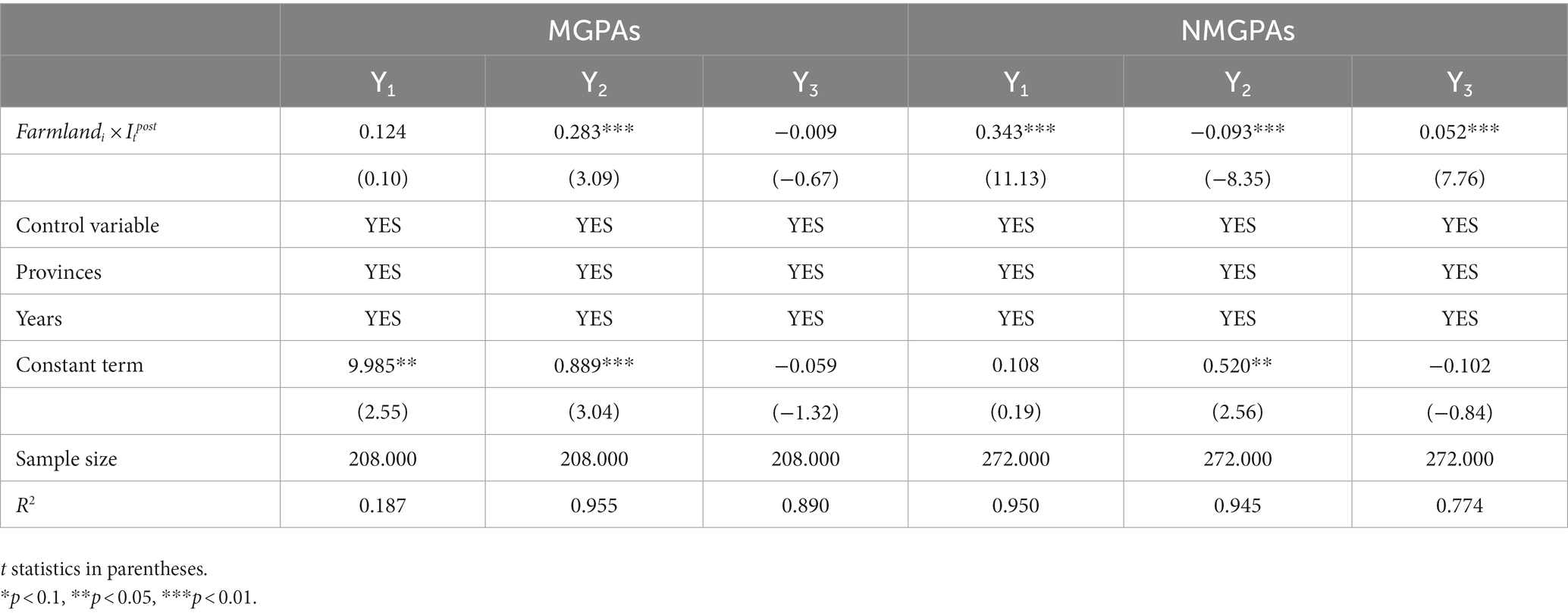
Table 8. Differential regression results of farm household income paths in agricultural production functional areas.
5 Conclusions and policy recommendations
This study utilizes panel data from 30 provincial-level administrative regions across China from 2006 to 2021, excluding Hong Kong, Macau, Taiwan, and Tibet. The continuous double difference (DID) model is employed to estimate the impact of the high-standard farmland construction policy on farmers’ income. The findings of this study are summarized as follows.
The analysis reveals that the implementation of the high-standard farmland construction policy has significantly increased farmers’ income. This conclusion is supported by the parallel trend test, dynamic effect analysis, and placebo test.
Heterogeneity analysis demonstrates that the impact of the high-standard farmland construction policy on farmers’ income varies across dimensions such as income disparity, food production functional areas, and geographical locations. Particularly, in food-producing regions, the policy exhibits the most significant effect on increasing farmers’ income, which is of great significance in reducing income disparities between food-producing and non-food-producing households.
Mechanism analysis indicates that the high-standard farmland construction policy promotes farmers’ income growth through improvements in agricultural production conditions, facilitation of land transfer, and cultivation of new agricultural management entities. These factors interact with each other and follow different pathways in different regions.
In conclusion, the high-standard farmland construction policy has a positive impact on farmers’ income growth. These findings provide important insights for further optimizing farmland construction policies and enhancing farmers’ income levels. However, we must acknowledge the limitations of this study. Firstly, data availability poses a constraint on our research. Due to these limitations, we were only able to utilize a limited number of years and a specific sample, conducting our analysis at the provincial level. Additionally, we were unable to control all potential confounding variables, which may have had an impact on our results. Despite implementing measures in our research design to minimize the potential for confounding, there remains a degree of uncertainty.
This study systematically explores the impact of the high-standard farmland construction policy on farmers’ income and provides an in-depth analysis of the underlying mechanisms. This offers a fresh perspective on understanding how agricultural policies influence farmers’ income. This paper puts forward the following suggestions.
Firstly, it is necessary to enhance support for high-standard farmland construction in major grain-producing regions. From a vertical perspective, greater financial support from the central government is needed for high-standard farmland construction in major grain-producing regions. Support standards specifically allocated for grain production areas within high-standard farmland construction should be increased. From a horizontal perspective, mechanisms for compensation and collaboration between non-grain-producing areas, especially grain-consuming areas, and major grain-producing areas need to be developed and improved.
Secondly, it is important to establish and improve mechanisms for high-standard farmland construction and management based on classification. In grain-producing areas, high-standard farmland construction should be considered as an important component of the compensation mechanism for the interests of grain-producing regions, thus maximizing the income-boosting effects of high-standard farmland construction in these areas. For non-grain-producing areas, although high-standard farmland construction in central regions may not have a direct significant impact on farmers’ income, it contributes to connecting small-scale farmers with modern agricultural development and indirectly promotes farmers’ income growth through the establishment of appropriate scales. Therefore, high-standard farmland construction in non-major producing areas should also receive due attention. This requires strict adherence to construction standards during the process of building high-standard farmland, emphasizing the quality of farmland construction, and improving mechanisms for monitoring and protecting high-standard farmland.
Thirdly, it is essential to coordinate the development of high-standard farmland construction with agricultural modernization. Improving the conditions for agricultural production, land circulation, and the cultivation of new agricultural entities should be the key focus of future high-standard farmland construction. The principles of “field quality, road connectivity, land leveling, suitable mechanization, drought irrigation, and flood drainage” should continue to be upheld, promoting land circulation and the cultivation of new agricultural entities. This approach can enhance agricultural operation scale and differentiation through land circulation, as well as leverage the driving effects of new agricultural entities on farmers, thereby jointly increasing farmers’ income.
Lastly, diverse financing paths for high-standard farmland construction should be explored. On one hand, a coordinated and integrated platform for agricultural funding, centered around high-standard farmland, should be established. This can be achieved by issuing local government special bonds and promoting public-interest projects under the PPP (Public-Private Partnership) model, which generates stable returns. These efforts can systematically involve financial institutions and capital from society in high-standard farmland construction, establishing mutually beneficial and cooperative mechanisms. On the other hand, the advantages of new agricultural entities in high-standard farmland construction should be leveraged. This can be achieved by vigorously promoting land ownership registration programs and establishing platforms for rural land circulation. Utilizing the financing and guarantee functions of agricultural land operation rights under the framework of “separating ownership, contract, and management rights,” new agricultural entities can be guided to participate in high-standard farmland construction through investment and labor, among other forms.
Finally, this study suggests that the success of China’s High Standard Farmland Construction provides some insights for agricultural development in other countries:
1. Prioritization of Major Grain Production Areas: China’s policy highlights the importance of Major Grain Production Areas and prioritizes them for farmland construction. This approach can help ensure food security and a stable supply of grain.
2. Implementation of mechanization and specialization in farmland: Increasing the level of agricultural production scale, mechanization, and specialization can enhance the productivity and quality of agriculture.
3. Innovation in agricultural entities: New agricultural entities such as family farms and agricultural cooperatives have played a significant role in China’s agricultural development. They provide better services and management, thereby improving income.
4. Benefit compensation mechanism: Ensuring that farmers reap adequate benefits from farmland construction is a critical factor for the success of the endeavor. This mechanism can incentivize farmers to actively participate in farmland construction and improve the efficiency of farmland use.
5. Emphasis on quality over quantity: China’s High-standard Farmland Construction emphasizes the quality of farmland rather than its quantity, which is a key to success. This strategy can help improve crop yield and quality.
6. Consideration of environmental protection and sustainability: China’s High-standard Farmland Construction also emphasizes environmental protection and sustainability, an aspect worth learning for other countries.
Data availability statement
Publicly available datasets were analyzed in this study. This data can be found here: China Bureau of Statistic.
Author contributions
CY: Writing – review & editing. SZ: Writing – original draft. WY: Conceptualization, Writing – review & editing. HY: Conceptualization, Writing – review & editing.
Funding
The author(s) declare financial support was received for the research, authorship, and/or publication of this article. This work was supported by Natural Science Foundation of Shandong Province (No. ZR2022MG075).
Conflict of interest
The authors declare that the research was conducted in the absence of any commercial or financial relationships that could be construed as a potential conflict of interest.
Publisher’s note
All claims expressed in this article are solely those of the authors and do not necessarily represent those of their affiliated organizations, or those of the publisher, the editors and the reviewers. Any product that may be evaluated in this article, or claim that may be made by its manufacturer, is not guaranteed or endorsed by the publisher.
References
Akhmadi, H., and Yekti, A. (2021). Impact of Agrotourism development on increasing value added of agricultural products and Farmers' income levels (a study in Karangtengah, Bantul, Yogyakarta). In E3S web of conferences (EDP Sciences.
Arsyad, M., Sabang, Y., Agus, N., Bulkis, S., and Kawamura, Y. (2020). Intercropping farming system and farmers income AGRIVITA. J. Agric. Sci. 42, 360–366. doi: 10.17503/agrivita.v42i2.2724
Barman, S., and Deka, N. (2019). Impact of farm mechanization on income of farmers in Assam, India. Asian J. Agric. Exten. Econ. Sociol. 30, 1–17. doi: 10.9734/ajaees/2019/v30i130100
Cai, F., Zhang, D., and Liu, Y. X. (2021). The impact of COVID-19 epidemic on China's labor market: a comprehensive analysis based on individual tracking surveys. Econ. Res. 56, 4–21.
Chen, J. H., and Hong, W. J. (2022). Does the construction of high-standard farmland promote land transfer? J. Zhongnan Univ. Econ. Law 2022, 108–117. doi: 10.19639/j.cnki.issn1003-5230.2022.0048
Deng, X., Zhang, M., and Wan, C. (2022). The impact of rural land right on farmers’ income in underdeveloped areas: evidence from Micro-survey data in Yunnan Province. China. Land 11:1780. doi: 10.3390/land11101780
Dong, H., Han, J., Zhang, Y., Chen, T., Fan, H., and Wang, C. (2023). Research on influencing factors of cultivated land productivity of high-standard farmland projects in Hanzhong City of China--an empirical study based on PLS-SEM. Front. Sustain. Food Syst. 7:1176426. doi: 10.3389/fsufs.2023.1176426
Geng, N., Gao, Z., Sun, C., and Wang, M. (2021). How do farmland rental markets affect farmers' income? Evidence from a matched renting-in and renting-out household survey in Northeast China. PLoS One 16:e0256590. doi: 10.1371/journal.pone.0256590
Gong, Y., Zhang, Y., and Chen, Y. (2023). The impact of high-standard farmland construction policy on grain quality from the perspectives of technology adoption and cultivated land quality. Agriculture 13:1702. doi: 10.3390/agriculture13091702
Guo, X., Wang, L., Meng, X., Dong, X., and Gu, L. (2023). The impact of digital inclusive finance on Farmers' income level: evidence from China's major grain production regions. Financ. Res. Lett. 58:104531. doi: 10.1016/j.frl.2023.104531
Kandpal, A., Kar, A., Jha, G., and Singh, P. (2019). Examining the role of farm mechanization in enhancing farmer's income: a panel data study of rice and wheat. J. Agrometeorol. 21, 26–30.
Lai, X. D., Du, Z. X., and Gao, L. L. (2021). The impact of joining cooperatives on the income of grain-based household farms: an empirical analysis based on nationwide panel data of 644 grain-based household farms. J. Nanj. Agric. Univ. 21, 143–155. doi: 10.19714/j.cnki.1671-7465.2021.0014
Lewis, W. A. (1954). Economic development with unlimited supplies of labour. The Manchester School, 22, 139–191. doi: 10.1111/j.1467-9957.1954.tb00021.x,
Li, L., Han, J., and Zhu, Y. (2023). Does environmental regulation in the form of resource agglomeration decrease agricultural carbon emissions? Quasi-natural experimental on high-standard farmland construction policy. J. Clean. Prod. 420:138342. doi: 10.1016/j.jclepro.2023.138342
Li, J. Y., and Qin, F. (2022). How to solve the demand dilemma of land transfer? Taking the development of new agricultural business entities as an example. Manage. World 38, 84–99+6. doi: 10.19744/j.cnki.11-1235/f.2022.0025
Linghu, L., Sun, P., Zhang, M., and Wu, Y. (2023). Data-driven projections demonstrate non-farming use of cropland in non-major grain-producing areas: a case study of Shaanxi Province. China. Agron. 13:2060. doi: 10.3390/agronomy13082060
Liu, Y., Liao, W., Zhang, X., and Qiu, H. (2023). Impact of high standard farmland construction policy on chemical fertilizer reduction: a case study of China. Front. Environ. Sci. 11. doi: 10.3389/fenvs.2023.1256028
Mishra, R. K., and Vedasri, R. (2021). A study on impact of farmer producer organisation on farmers’ income in Andhra Prdesh. Asian J. Agric. Exten. Econ. Sociol. 39, 7–18. doi: 10.9734/AJAEES/2021/V39I830619
Mutelo, A. M., Zhen, C., Wei, S., and Hamukwaya, S. L. (2023). High-standard farmland destruction monitoring by high-resolution remote sensing methods: a 2017–2018 case study of Hebei and Guangdong China. Environ. Monit. Assess. 195:742. doi: 10.1007/s10661-023-11354-y
Nandini, R., and Rahayu, A. A. D. (2021). The role of land management in increasing the income of private Forest farmers in Central Lombok regency. In IOP Conference Series: Earth and Environmental Science IOP Publishing.
Peng, J., Zhao, Z., and Chen, L. (2022). The impact of high-standard farmland construction policy on rural poverty in China. Land 11:1578. doi: 10.3390/land11091578
Qian, N. (2008). Missing women and the price of tea in China: the effect of sex-specific earnings on sex imbalance. Q. J. Econ. 123, 1251–1285. doi: 10.1162/qjec.2008.123.3.1251
Qian, Z. H., and Wang, X. W. (2016). How does land transfer promote increased income for rural households? An empirical analysis based on survey data from four provinces (regions) of Su, Gui, E, and Hei. Chin. Rural Econ. 2016, 39–35.
Sang, X., Luo, X., Razzaq, A., Huang, Y., and Erfanian, S. (2023). Can agricultural mechanization services narrow the income gap in rural China? Heliyon 9:e13367. doi: 10.1016/j.heliyon.2023.e13367
Schultz, T. W. (1950). Reflections on poverty within agriculture. J. Polit. Econ. 58, 1–15. doi: 10.1086/256894
Singh, R., Passah, S., Singh, N. A., Feroze, S. M., Anuradha Devi, A., Kumar, S., et al. (2021). Organic chilli production in the north Eastern Hill region, India: value chain analysis for doubling farmers’ income. Agric. Econ. Res. Rev. 34, 243–252. doi: 10.5958/0974-0279.2021.00032.X
Wang, L., Zhang, F., Wang, Z., and Tan, Q. (2021). The impact of rural infrastructural investment on farmers' income growth in China. China Agric. Econ. Rev. 14, 202–219. doi: 10.1108/CAER-09-2020-0211
Wei, H. K., and Wang, Y. Q. (2012). The theoretical basis and policy orientation of central support for the development of major grain-producing areas. Economic. Dynamics 2012, 49–55.
Wu, Y., and Ma, Y. J. (2021). The impact of family farms on farmers' income: estimation based on inter-provincial data. Econ. Issues 2021, 104–111. doi: 10.16011/j.cnki.jjwt.2021.04.014
Xi, J. P. (2022). Holding high the great banner of socialism with Chinese characteristics and working together for the comprehensive construction of a modern socialist country - Report at the 20th National Congress of the Communist Party of China.Central people’s government of the People’ s Republic of China. https://www.gov.cn/xinwen/2022-10/25/content_5721685.htm
Xiong, Y., and Li, Y. (2021). Study on water-saving irrigation for high standard farmland construction. Acad. J. Environ. Earth Sci. 3, 1–5. doi: 10.25236/ajee.2021.030101
Yang, T., Chandio, A. A., Zhang, A., and Liu, Y. (2023). Do farm subsidies effectively increase grain production? Evidence from major grain-producing regions of China. Foods 12:1435. doi: 10.3390/foods12071435
Yang, B., Li, Y., and Jiang, Y. (2020). On land transfer, farmers' income, and targeted poverty alleviation: based on the analysis of DID model. Francis Acad. Press 12, 109–128. doi: 10.25236/AJBM.2020.020213
Ye, D., Zhen, S., Wang, W., and Liu, Y. (2023). Spatial double dividend from China’s main grain-producing areas policy: total factor productivity and the net carbon effect. Human. Soc. Sci. Commun. 10, 1–22. doi: 10.1057/s41599-023-01962-x
Yi, H. (2012). Comparative study on a moderate scale management of agricultural land in China and Japan. Stud. Sociol. Sci 3, 66–69. doi: 10.3968/j.sss1923018420120302.1600
Zhang, H. P., and Qu, T. T. (2014). Transfer of agricultural land management rights and the development of new agricultural operating entities. J. Nanjing Agric. Univ. 14, 70–75+83.4.
Zhao, Y., and Sun, X. T. (2022). Does the construction of high-standard farmland promote the cultivation of new professional farmers? Evidence from villages. Rural Econ. 2022, 135–144.
Zheng, S., Yu, L., and Fu, H. (2023). Has rural E-commerce increased potato farmers’ income? Evidence from the potato home of China. Potato Res., 1–21. doi: 10.1007/s11540-023-09614-y
Zhou, Y., Guo, L., and Liu, Y. (2019). Land consolidation boosting poverty alleviation in China: theory and practice. Land Use Policy 82, 339–348. doi: 10.1016/j.landusepol.2018.12.024
Keywords: agricultural policy, high-standard basic farmland, farmers’ income, difference-in-differences model, causal inference
Citation: Yusheng C, Zhaofa S, Yanmei W and Yang H (2023) Impact of high-standard farmland construction on farmers’ income growth—quasi-natural experiments from China. Front. Sustain. Food Syst. 7:1303642. doi: 10.3389/fsufs.2023.1303642
Edited by:
José Antonio Teixeira, University of Minho, PortugalReviewed by:
Peng Jiquan, Jiangxi University of Finance and Economics, ChinaYouliang Ning, Chinese Academy of Forestry, China
Xiaozhong Li, Northeast Agricultural University, China
Copyright © 2023 Yusheng, Zhaofa, Yanmei and Yang. This is an open-access article distributed under the terms of the Creative Commons Attribution License (CC BY). The use, distribution or reproduction in other forums is permitted, provided the original author(s) and the copyright owner(s) are credited and that the original publication in this journal is cited, in accordance with accepted academic practice. No use, distribution or reproduction is permitted which does not comply with these terms.
*Correspondence: Chen Yusheng, MjAxMDAxOUBvdWMuZWR1LmNu
 Chen Yusheng
Chen Yusheng Sun Zhaofa1
Sun Zhaofa1